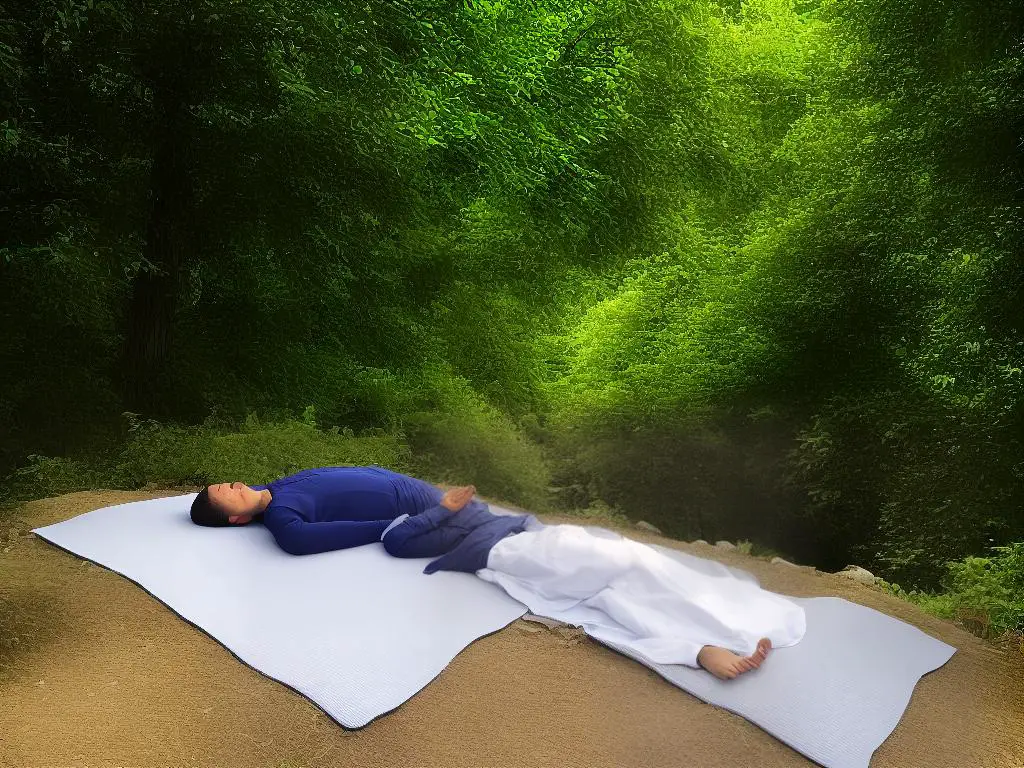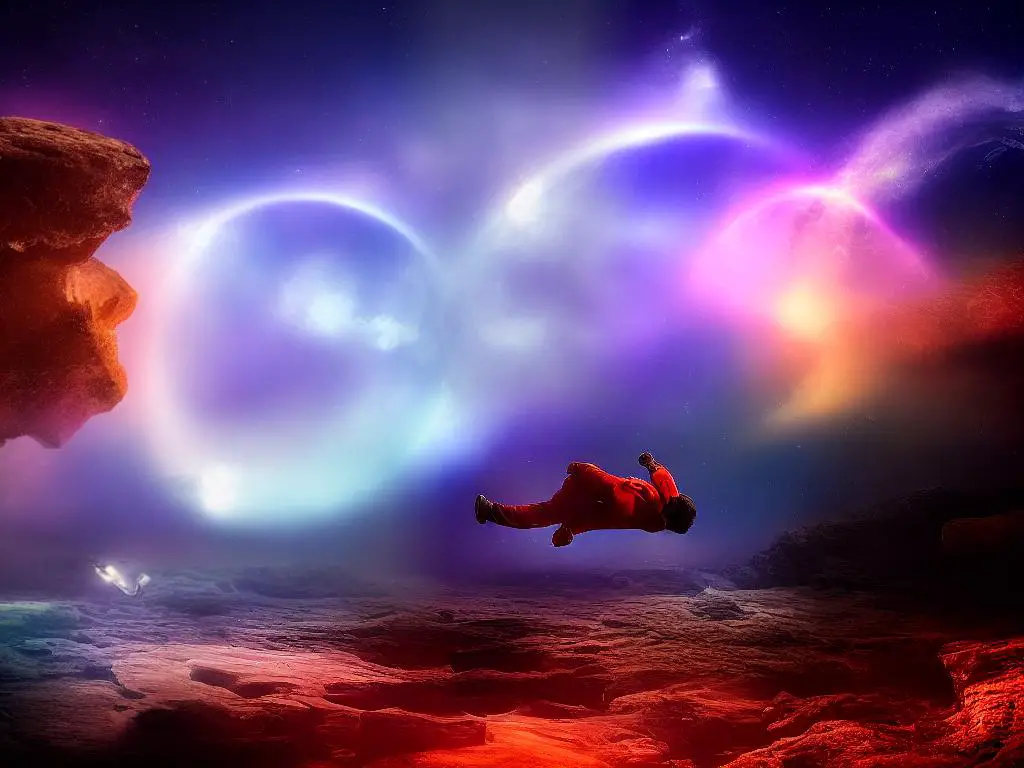The practice of astral projection has long captivated the imaginations of those seeking to experience a realm beyond the physical world. Through the ages, this phenomenon has been explored by ancient cultures, religious traditions, and modern science. This intriguing journey into astral realms allows individuals to access seemingly inaccessible experiences, including the lives of others. This exploration delves into the depths of astral projection, its methods and techniques, as well as the potential ethical considerations and scientific viewpoints surrounding this phenomenon.
Understanding Astral Projection
Astral projection, also known as an out-of-body experience (OBE), is a phenomenon wherein an individual’s consciousness separates from the physical body to travel and explore the astral plane, an alternate dimension or reality. This concept has been a part of various religious, spiritual, and esoteric traditions, and has intrigued people for centuries. Ancient cultures, such as the Egyptians and Greeks, had beliefs surrounding soul travel or the spirit leaving the body to visit other realms. Modern interpretations of astral projection encompass both science and spirituality, with some considering it a natural human ability or an extension of consciousness, while others view it as a paranormal or supernatural event.
One of the many theories surrounding astral projection is that during the experience, individuals are tapping into an interconnected web of consciousness or collective consciousness, which allows them to access the experiences and lives of other people. This idea of a shared, universal consciousness is deeply rooted in Eastern philosophies and religious traditions, such as Hinduism and Buddhism, and has gained traction in modern psychology and parapsychology. Some proponents of this concept argue that during astral travel, individuals are able to experience the emotions, memories, and sensations of someone else as if they were their own.
Practitioners of astral projection often employ specific techniques to induce an out-of-body experience. These techniques may include hypnosis, meditation, lucid dreaming, or the use of specific sound frequencies to alter the brain’s state of consciousness. Reports of astral projection experiences often involve entering a vibrational or energetic state in which the individual’s perception of their surroundings becomes altered, and they feel themselves begin to separate from their physical body. Some individuals claim to have encountered other beings or entities while in the astral state, leading to speculation about the nature of the astral plane and its inhabitants.
Skeptics of astral projection often argue that the experiences reported by those who have undergone OBEs can be explained by various neurological and psychological factors, such as sleep paralysis, lucid dreaming, or even hallucinations. Research into the subject remains inconclusive, with some studies suggesting that it may be possible to induce an out-of-body experience through specific stimulation of the brain, while others question the veracity of such experiences and propose alternative explanations rooted in cognitive functioning.
The concept of astral projection, specifically experiencing someone else’s life through this phenomenon, continues to captivate both believers and skeptics alike. As research and exploration into the nature of consciousness advances, interests in the potential of tapping into a shared collective unconscious are piqued, with ancient spiritual traditions further influencing our understanding of reality and the human experience.

Methods & Techniques
One method commonly employed in the pursuit of astral projection is meditation, which allows individuals to clear their minds and achieve the deep relaxation necessary for an out-of-body experience. By focusing on one’s breath or a specific object, practitioners can quiet mental chatter and become more attuned to their inner consciousness. Various meditation techniques, such as guided meditation, mantra-based meditation, and mindfulness meditation, provide individuals with options to find the approach that suits them best. In addition to practicing meditation, creating a peaceful and quiet environment is critical in helping the individual concentrate on reaching the astral plane.
Visualization techniques also play a significant role in astral projection, as the ability to imagine oneself leaving their physical body and traveling to another plane is essential. One popular visualization technique is the “rope method,” where the individual imagines reaching out and climbing a rope, using this mental perception to separate their astral body from their physical form. Another common method is the “target technique,” which involves focusing on a specific object or location in your room or home and attempting to move towards it within your mind visually. Practicing these visualization exercises regularly can help increase the likelihood of achieving a successful astral projection experience.
Breathing exercises are another fundamental aspect of astral projection, as they assist in calming the body and mind and creating a heightened sense of awareness. Practitioners often use deep, slow breaths in combination with visualization techniques to encourage relaxation, increase mental clarity, and prepare for astral travel. It’s crucial to maintain a steady and consistent breathing rhythm, as irregular breathing patterns can impede the achievement of the necessary mental state. Techniques such as the 4-7-8 method or diaphragmatic breathing can be beneficial in helping an individual control their breathing and induce a more profound meditative state.
Binaural beats and sound frequencies can also support the process of astral projection, as they can help the brain achieve the necessary altered state of consciousness. With the use of headphones, binaural beats rely on playing two slightly different sound frequencies into each ear, encouraging the brain to create a third tone and enter a specific brainwave state. This synchronization of brainwaves is thought to enhance meditation, relaxation, and concentration, ultimately making it easier to induce astral projection experiences.
Mastering astral projection requires maintaining a consistent practice and being patient with yourself. It’s important to remember that each individual’s journey will be unique, and finding the best combination of methods and techniques may require some experimentation. By dedicating time and effort to practice and familiarize oneself with the various astral projection techniques, an individual can increase their chances of achieving a successful out-of-body experience and exploring the astral plane.

Experiencing Someone Else’s Life
Experiencing Someone Else’s Life Through Astral Projection
One of the most intriguing aspects of astral projection is the possibility of experiencing someone else’s life through an out-of-body state. This phenomenon, also known as “soul traveling,” allows a person’s consciousness to temporarily detach from their physical body and travel the astral plane. Through this process, some individuals claim they have obtained an intimate understanding of another person’s experiences, thoughts, and emotions – effectively “walking a mile in their shoes.”
Anecdotal Accounts of Life-Changing Empathy Gain through Astral Projection
Numerous anecdotal accounts from astral projectors suggest that this phenomenon is not only possible, but potentially life-changing. Experiencers describe feeling a strong empathetic connection to the person whose life they have temporarily entered, often carrying lessons and insights from the experience back into their own reality. By stepping outside of their own perspective, individuals who have delved into another’s life through astral projection often report having gained a more profound understanding of the human experience. This could lead to more compassion, tolerance, and sympathy towards others in their daily life.
Ethical Concerns and Challenges of Such Experiences
However, the concept of entering another person’s life through astral projection raises various ethical concerns. Is it morally acceptable to invade someone’s privacy, even for the sake of personal growth? Additionally, the very subjectivity of these experiences makes the line between genuine understanding of another’s life and emotional projection quite blurry. One could argue that astral journeyers may be influenced by their preconceived notions and personal biases, thus distorting the authenticity of the experience.
The Spiritual and Introspective Potential of Such Experiences
A counterpoint to these ethical dilemmas lies in the spiritual and introspective potential of such experiences. Scholars in the field of consciousness studies have posited that astral projection may help individuals explore the boundaries of self and the deeper, shared nature of human reality. The profound empathy and connection that can result from experiencing another person’s life through astral projection may indeed foster a sense of interconnectedness and challenge the societal constructs that often divide us.
Exploring Astral Projection for Personal Growth and Self-Awareness
Astral projection refers to the experience of a person’s consciousness leaving their physical body and experiencing reality from a non-physical standpoint. Though it has been prevalent in various religions and spiritual practices for centuries, its legitimacy has always been a subject of skepticism in the scientific community.

Scientific and Psychological Perspectives
Moreover, experiencing another person’s life through astral projection has the potential to facilitate personal growth and self-awareness. By stepping into another’s shoes, individuals can gain a deeper understanding of their own motivations, desires, and beliefs, as well as the ways in which they may inadvertently contribute to societal divisions. Ultimately, this unique aspect of astral projection could lead not only to improved interpersonal relations but also to a more harmonious, empathetic society overall.
Theories suggest that OBE experiences can be explained by various physiological and psychological factors that occur during sleep and near-death experiences. Some researchers argue that it’s a construct of the mind, while others believe that lucid dreaming could be a form of astral projection.
One of the most famous studies on OBE was conducted in 2007 by neuroscientist Dr. Olaf Blanke, which found that a specific area in the brain’s right angular gyrus was responsible for generating OBEs.
Advancements in technology have allowed researchers to simulate out-of-body experiences through virtual reality immersion, aiding our understanding of human consciousness and the concept of astral projection. This phenomenon has been a subject of fascination for centuries and is believed to offer potential benefits in the realm of self-improvement.

Practical Applications & Benefits
One notable practical application of astral projection lies in enhancing our self-awareness and promoting personal growth. By disconnecting one’s consciousness from their physical body and exploring the astral plane, individuals have reported gaining new insights into themselves, often finding solutions to personal challenges and uncovering ways to improve their lives overall. By experiencing a broader perspective than offered by our day-to-day existence, astral projection can contribute to an enhanced sense of self-awareness and overall personal development.
Empathy-building is another practical benefit of astral projection and experiencing someone else’s life. When we have the opportunity to experience the world through the eyes of another person, we can more easily understand their experiences, feelings, and motivations. This newfound understanding can lead to increased compassion and empathy, ultimately promoting a stronger connection between people and fostering a more supportive and understanding society.
In addition to self-improvement and empathy-building, astral projection and experiencing someone else’s life can offer a unique opportunity for personal growth. By encountering different perspectives and life situations in our astral travels, we expose ourselves to a wealth of diverse experiences that can challenge us to think critically about our own lives and push us to grow as individuals. This exchange of perspectives can spark a profound transformation within ourselves, allowing us to identify our areas for growth and progress.
Moreover, the practice of astral projection can contribute to our understanding of the world around us. By encountering the vast array of cultures, beliefs, and communities present on the astral plane, we can learn to appreciate the rich tapestry of human experience and recognize the interconnectedness of all living beings. This increased understanding can drive us to be more responsible global citizens, conscious of our actions and the impact they have on those around us.
Finally, engaging in astral projection and experiencing another person’s life can also foster a heightened sense of gratitude for our own lives. Confronted with new perspectives and experiences, we can come to appreciate the uniqueness of our own existence and find value in the trials and challenges we face. By acknowledging the shared human experience and learning from those who face a different set of obstacles, we can cultivate a deeper sense of resiliency and a newfound gratitude for our own lives, contributing to a more fulfilling and content existence.

Ultimately, the mysterious world of astral projection and the unique experiences it can provide offer a fascinating avenue for personal growth and self-discovery. With methods and techniques that can be tailored to individual preferences, as well as potential benefits for increased empathy and understanding of others, astral travel may indeed have a valuable role to play in our quest for self-improvement and global harmony. Whatever your perspective may be on this enigmatic subject, one thing is certain: the exploration of astral projection offers a tantalizing glimpse into the vast potential of human consciousness and experience.
